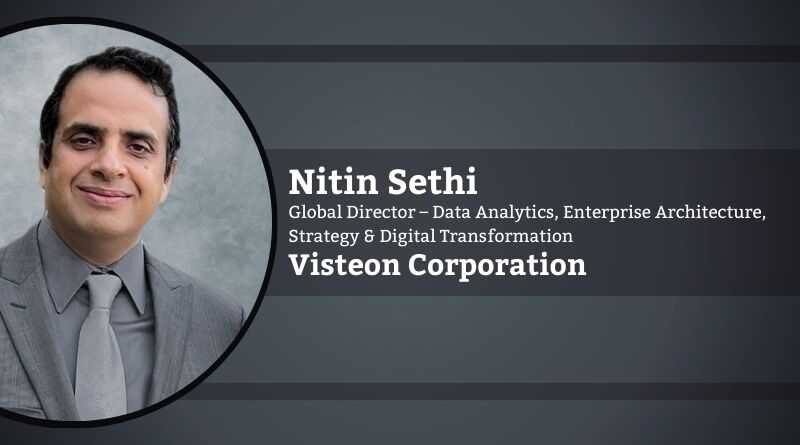From Philosophy to Practice: Driving Industry 4.0 into Action
By Nitin Sethi, Global Director – Data Analytics, Enterprise Architecture, Strategy, and Digital Transformation, Visteon Corporation
The manufacturing industry is transforming at a remarkable pace. At the same time, companies of all sizes are dealing with significant challenges in managing skilled labor shortages, supply chain volatility, and inflation headwinds, compelling manufacturers to look for ways to manage disruption and drive innovation. In the new industry paradigm, every aspect of the supply chain is a potential candidate to be disrupted and needs to be analyzed and transformed to create a competitive advantage in the marketplace. Industry 4.0 as a philosophy and its underlying tenets around Automation, Digitalization, and Data analytics are perceived as critical ammunitions to transform and elevate organizations to the next pedestal. These are perceived to be magic bullets for Improving equipment effectiveness, labor utilization, and predictable supply chains. However, with millions of dollars spent on these initiatives, companies are still in a vicious loop of achieving their business goals and seeing significant measurable business value.
Adopting the “Cloud First” strategy helps bring agility to IT functions and helps accelerate I4.0 initiatives.
Building a cohesive roadmap to implement Industry 4.0 initiatives requires a strong foundation and a clear framework. In my view, the following framework can help organizations to translate Industry 4.0 into action and achieve tangible benefits.
Strengthen the core: This involves putting a focus and investments into strengthening core systems involving ERP, MES, and PLM, which act as pillars to analytics architecture that connects machines and the entire enterprise, allowing to use of artificial intelligence (AI), machine learning, and other I4.0 technology to collect data, provide insights, solve problems, and keep operations humming. To keep pace with digital disruption, future-proofing core enterprise IT is a new corporate imperative; it’s essential that the IT dept put a strong impetus on enterprise architecture, integration, network, and infrastructure modernization complemented by DevOps and program management practices. Adopting the “Cloud First” strategy helps bring agility to IT functions and helps accelerate I4.0 initiatives.
Putting Data in Driving Seat: It’s vital to evangelize data-driven decision-making, which implies creating data literacy in an organization and putting a data strategy together, focusing on the completeness, accuracy, and relevance of data. In my experience, many companies tread a path of Data Visualization and analysis without putting effort into setting a foundation of data ingestion, storage, and lineage. This is synonymous to start developing a high-rise building without putting a solid foundation in place, the result of which is very self-evident. There should well be thought architecture and approach required to get data out of systems, store and publish it to decision-makers in a self-serve format. An effective data strategy is a win-or-bust factor in successful I4.0 implementation, and without this essential foundation, any additional I4.0 strategies could fail.
Regarding data analytics, there must be a proper segregation of responsibilities between IT and Business Teams. The IT team should spend all their efforts and energy building the data fabric and providing Data as a service. In contrast, business data analysts and data engineers should concentrate on building artifacts and predictive algorithms to achieve business outcomes around the supply chain, monitoring the machine’s effectiveness, and improving real-time asset utilization. With efficient data fabric and technologies about AI/ML, manufacturers can harness benefits around the increased life of machines and equipment through predictive maintenance and optimize the scheduling of production lines by using techniques involving Digital Twins.
Some of the critical factors overlooked in this journey and should be considered are
- Data strategy should not drive business strategy; instead, business strategy should be infused with data and analytics.
- Don’t make governance a tool to kill innovation
- Since Cloud gave unlimited space, that doesn’t imply we get anything and everything. Capture data that is insightful and create business impact.
- Go small, but think big.
- Make Data Security and Privacy part of the process and not the aftermath activity to fix.
Bridge Information (IT) and Operations Technology (OT)
Amalgamating IT and OT to IIOT platform democratizes access to data and technology across the value chain and accelerates I4.0 Initiatives; this new architecture helps establish standard governance standardization and assists harmonization across processes, KPIs, skills, data, and security guidelines; with this architecture, it is best practice for OT systems to leverage edge-based cloud options in factories to improve compatibility with central IIoT platforms that use public and private clouds. IT-OT convergence addresses technological aspects and has an overarching organizational change management impact; it warrants the support and synergy from CIO and COO and effective communication and cross-training throughout the process. IT and OT convergence also demand a focus on bridging the security gap between IT and OT. Several design concepts like network segmentation, multi-factor authentication, SOC, and firewalls can help elevate the challenges.
Workforce and Process digitalization: Industry 4.0, like any Digital Transformation initiative, relies on Data, Technology, Process, and People. Maximizing I4.0 investment necessitates increased importance on employees nurtured into new technologies and supported by common and standard processes. Current staff must be trained to operate and maintain new technologies; they should also be data literate, empowering all employees to ask the right questions about data and machines, build knowledge, make decisions, and communicate meaning to others. This helps optimize labor productivity by eliminating low-value tasks and redirecting people toward those activities that move the needle. Disruption and acclimatization will be fundamental for companies to grow and transform in the coming years; thus, realizing the potential of Industry 4.0 can become a true differentiator for manufacturers. I strongly suggest that companies start familiarizing themselves with what I4.0 could mean for them and build the vision and roadmap. I4.0 is a journey; You cannot go from 0% to 100% goal attainment automatically or overnight, so embark on it and follow a proven philosophy of crawl, walk and run to take your organization to the next pedestal of maturity.

